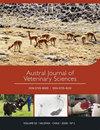墨西哥墨西卡利市宠物犬肠道寄生虫频率及危险因素分析
IF 0.8
4区 农林科学
Q3 VETERINARY SCIENCES
引用次数: 0
摘要
. 狗的肠道寄生虫感染对人类健康是一个问题,因为各种各样的寄生虫都有人畜共患的可能。因此,与宠物接近会使我们处于危险之中。本研究的目的是确定在墨西哥下加利福尼亚州墨西卡利市一家兽医医院就诊的狗粪便中肠道寄生虫的频率和危险因素(年龄、性别、体型、品种、有无体外寄生虫和胃肠道疾病)。收集犬类患者粪便148份,进行寄生虫鉴定和寄生虫载量分析。12.2%(18/148)的样本呈肠道寄生虫感染阳性。特异性感染频率以隐孢子虫为8.1%,其次为囊异孢子虫2.7%,狮子弓形虫1.4%。肠道寄生虫的存在与杂种品种之间存在统计学意义。原生动物的优势显示了在使用驱虫药物治疗之前进行诊断的重要性,因为通常使用预防性抗寄生虫方案,尽管这些特定的寄生虫不在这些药物的范围内。隐孢子虫属具有人畜共患的可能性,特别是在免疫功能低下的患者中,并且很少或没有治疗选择。本文章由计算机程序翻译,如有差异,请以英文原文为准。
Frequency and risk factors of intestinal parasites in pet dogs from Mexicali, Mexico
. Parasitic intestinal infections in dogs represent a problem for human health, because a wide variety of these parasites have zoonotic potential. Therefore, proximity to pets puts us at risk. The objective of this study was to determine the frequency and risk factors (age, sex, size, breed, presence of ectoparasites and gastrointestinal disorders) of intestinal parasites in the feces of dogs attending a Veterinary Hospital in the City of Mexicali, Baja California, Mexico. A total of 148 fecal samples were collected from canine patients and analyzed for parasite identification and parasite load. A 12.2% (18/148) of the samples were positive to parasitic intestinal infections. The frequency of specific infections was an 8.1% of Cryptosporidium sp ., followed by a 2.7% of Cystoisospora sp., and 1.4% of Toxascaris leonina. A statistical significance was identified between the presence of intestinal parasites and mongrel breed. The predominance of protozoa shows the importance of diagnosis prior to treatment with anthelminthic drugs, since preventive antiparasitic protocols are commonly used, although these particular parasites are out of the spectrum of those drugs. Cryptosporidium spp . have zoonotic potential, particularly in immunocompromised patients, and there are few or no treatment options.
求助全文
通过发布文献求助,成功后即可免费获取论文全文。
去求助
来源期刊

Austral Journal of Veterinary Sciences
Veterinary-General Veterinary
CiteScore
1.60
自引率
0.00%
发文量
18
期刊介绍:
Austral Journal of Veterinary Sciences (formerly Archivos de Medicina Veterinaria) publishes original scientific contributions in English, containing the latest developments and discoveries in veterinary sciences. The journal covers topics such as animal health and production, preventive medicine, zoonosis, pharmacology and therapeutics, methods of diagnosis, and other areas related to the veterinary field.
Austral Journal of Veterinary Sciences aims to divulge information about advances in veterinary medicine among universities, research centres, industries, government agencies, biologists, agronomists and veterinarians.
 求助内容:
求助内容: 应助结果提醒方式:
应助结果提醒方式:


